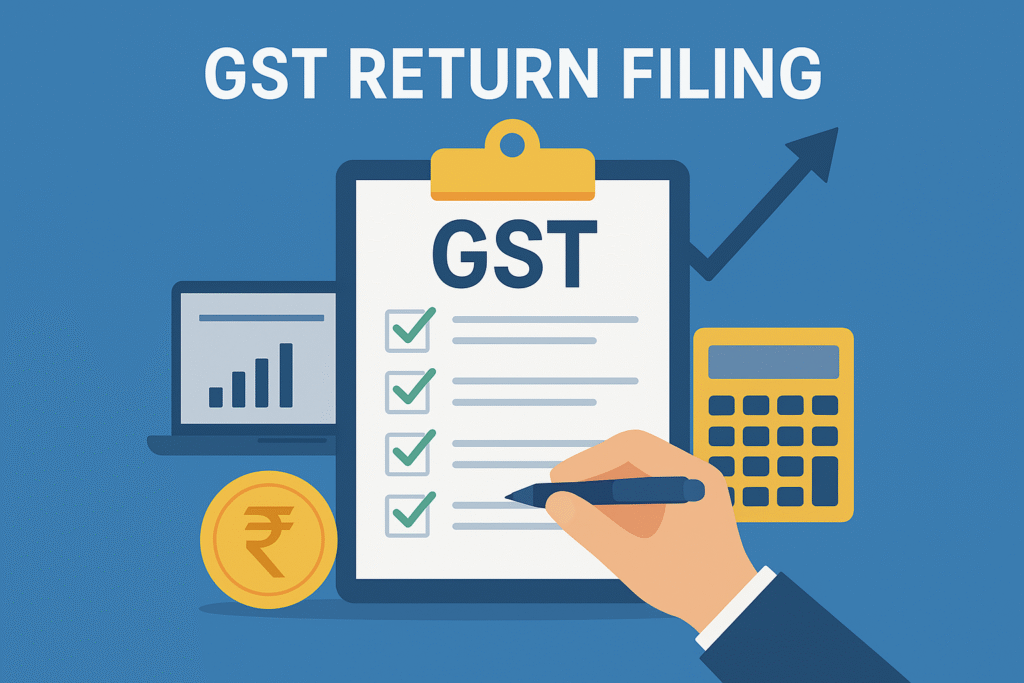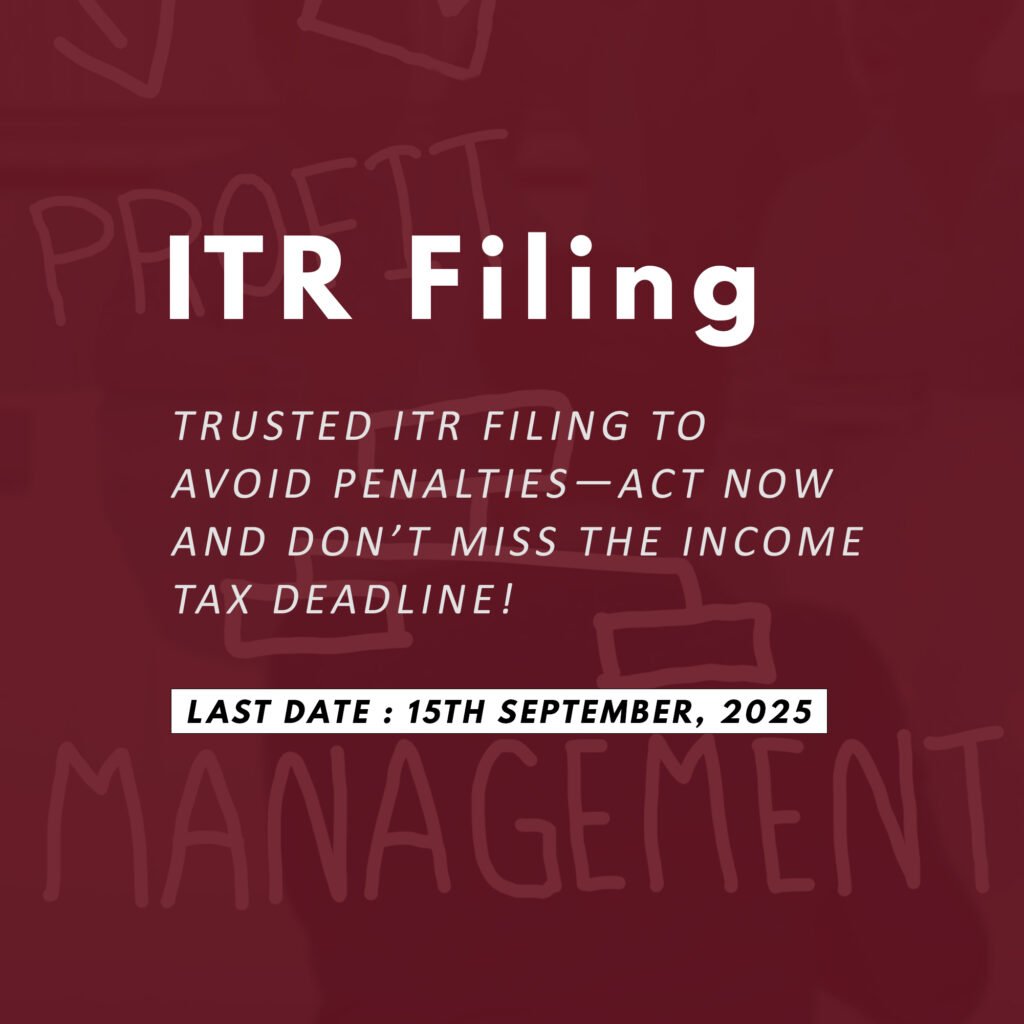GST Return Filing: A Complete Step-by-Step Guide for Businesses (2025)
The introduction of Goods and Services Tax (GST) has revolutionized India’s indirect tax system by replacing multiple taxes like VAT, excise duty, and service tax with one unified tax. However, many business owners still find GST return filing confusing and stressful.
Whether you are a small business owner, startup founder, or a large enterprise, filing your GST returns on time is crucial to stay compliant, avoid penalties, and maintain a smooth Input Tax Credit (ITC) flow.
In this detailed guide, we’ll explain everything you need to know about GST return filing in India, including:
- What GST return filing is and why it matters
- Different types of GST returns
- Step-by-step process to file GST returns online
- Due dates and penalties
- Common mistakes to avoid
- Practical tips for faster and error-free GST filing
By the end of this guide, you’ll be confident about handling your GST compliance effortlessly.

What is GST Return Filing?
GST return filing is the process of submitting tax-related information to the government through the GST portal. It includes details about:
- Sales (Outward Supplies) – Goods or services you’ve sold.
- Purchases (Inward Supplies) – Goods or services you’ve purchased.
- Input Tax Credit (ITC) claimed – Tax credit you are eligible for.
- Taxes paid and taxes payable – Amount of GST collected vs. payable.
Every registered business under GST must file returns regularly, even if there are no transactions in a particular month. In that case, you are required to file a Nil Return.
Pro Tip: Timely GST return filing ensures compliance, helps avoid penalties, and builds trust with vendors and customers.
Why GST Return Filing is Important
Filing your GST returns on time is not just a legal formality. It directly impacts your business operations and financial health. Here’s why it matters:
- Avoid Penalties and Late Fees
Late filing attracts fines of ₹50 per day (₹20 for Nil returns) plus 18% annual interest on outstanding tax. - Ensure Smooth ITC Flow
Accurate and timely filing ensures you can claim Input Tax Credit without disruptions. - Maintain Compliance Rating
The government assigns compliance ratings to businesses, which lenders and vendors consider before partnerships. - Prevent Business Disruptions
Non-compliance can result in ITC blockage or even GST registration suspension. - Build Vendor and Customer Trust
Regular filing signals that your business is reliable and transparent.
Who Should File GST Returns?
All entities registered under GST are required to file returns, including:
- Regular taxpayers – Most businesses fall under this category.
- Composition scheme dealers – Businesses with turnover below ₹1.5 crore opting for simplified tax rates.
- E-commerce operators – Platforms selling goods and services online.
- Input Service Distributors (ISD) – Businesses distributing tax credit to branches.
- Non-resident taxable persons – Foreign businesses supplying goods or services in India.
- TDS/TCS deductors – Entities deducting or collecting tax at source.
Even if there is zero business activity, you must file a Nil return to avoid fines and maintain compliance.
Types of GST Returns in India
Here’s a quick breakdown of the most common GST return types and their purposes:
Return Type | Who Files It | Frequency | Purpose |
GSTR-1 | Regular taxpayers | Monthly/Quarterly | Details of outward supplies (sales) |
GSTR-3B | Regular taxpayers | Monthly | Summary of sales, purchases, and tax paid |
GSTR-4 | Composition dealers | Annually | Annual return for composition scheme |
GSTR-5 | Non-resident taxpayers | Monthly | Details of inward & outward supplies |
GSTR-6 | Input Service Distributors | Monthly | Distribution of ITC |
GSTR-7 | TDS deductors | Monthly | Details of tax deducted at source |
GSTR-8 | E-commerce operators | Monthly | Details of supplies & TCS collected |
GSTR-9 | Regular taxpayers | Annually | Summary of the year’s GST activities |
GSTR-9C | Businesses with turnover > ₹5 crore | Annually | Reconciliation statement & audit report |
Note: For most businesses, GSTR-1 and GSTR-3B are the two most frequently filed returns.
Step-by-Step Process for GST Return Filing Online
Filing your GST return online is easier than you think. Follow these simple steps:
Step 1: Log in to the GST Portal
Visit www.gst.gov.in and log in using your username, password, and captcha code.
Step 2: Go to the Returns Dashboard
- Navigate to Services > Returns > Returns Dashboard.
- Select the financial year and return filing period.
Step 3: Select the Applicable Return Form
Choose the correct form like GSTR-1 or GSTR-3B based on your business type and filing requirement.
Step 4: Enter Return Details
- Add sales and purchase details manually or by uploading invoices.
- Use the prescribed format for bulk uploads.
- Verify auto-populated fields from the GST system.
Step 5: Reconcile Input Tax Credit (ITC)
- Match ITC with your suppliers’ filings (GSTR-2A/2B).
- Resolve mismatches to prevent ITC rejection.
Step 6: Preview and Review
Before final submission, preview your return to ensure all data is accurate.
Step 7: Make Tax Payment (If Required)
Pay additional tax liability using:
- Net banking
- Debit/credit card
- NEFT/RTGS
Step 8: File Using DSC or EVC
Complete the filing by authenticating through a Digital Signature Certificate (DSC) or Electronic Verification Code (EVC).
GST Return Filing Due Dates in 2025
Return Type | Due Date |
GSTR-1 (Monthly) | 11th of next month |
GSTR-3B (Monthly) | 20th of next month |
GSTR-1 (Quarterly under QRMP) | 13th of month following the quarter |
GSTR-9 (Annual Return) | 31st December of following FY |
Note: Dates may shift if they fall on weekends or public holidays.
Penalties for Late GST Return Filing
Failing to file returns on time can be expensive. Here’s what you’ll face:
- Late Fee
- ₹50 per day (₹25 each for CGST and SGST).
- ₹20 per day for Nil returns.
- Maximum late fee capped at ₹5,000.
- Interest
- 18% per annum on outstanding tax amount.
- ITC Blockage
- You cannot claim Input Tax Credit until pending returns are filed.
- Legal Consequences
- Persistent non-compliance may lead to GST registration suspension or cancellation.
Benefits of Timely GST Return Filing
Filing GST returns on time offers several business advantages:
- ✅ Uninterrupted ITC claims for better cash flow.
- ✅ Avoid penalties and fines, saving money.
- ✅ Boosts compliance rating, helpful for loans and contracts.
- ✅ Strengthens vendor relationships, as compliant businesses are preferred.
- ✅ Peace of mind, knowing your tax compliance is up to date.
Common Mistakes to Avoid During GST Return Filing
Avoid these common errors to ensure smooth filing:
- ❌ Wrong GSTIN entry for vendors or customers.
- ❌ Uploading invoices twice or missing some invoices.
- ❌ Not reconciling GSTR-2A/2B with purchase records.
- ❌ Using incorrect HSN/SAC codes.
- ❌ Assuming Nil returns aren’t mandatory – they are!
Expert Tips for Easy and Accurate GST Filing
- ✅ Keep accounting records updated
- ✅ Reconcile Input Tax Credit every month before filing.
- ✅ Use GST software or ERP systems for automation.
- ✅ Maintain a compliance calendar to track due dates.
- ✅ Consider hiring a GST consultant if your turnover is high.
How Technology Can Simplify GST Return Filing
Modern accounting software can make GST filing much easier by:
- Auto-generating reports for GSTR-1 and GSTR-3B.
- Tracking invoices and preventing duplication.
- Matching ITC automatically with supplier data.
- Sending reminders for upcoming due dates.
Investing in the right technology saves time and reduces human error.
Final Thoughts
GST return filing is more than just a legal requirement – it’s a critical part of running a compliant and trustworthy business. Timely and accurate filing ensures you can claim ITC without hassle, maintain a good compliance rating, and build stronger relationships with vendors and customers.
Whether you are a small business owner under the composition scheme or a large enterprise with multiple GSTINs, understanding the process and staying consistent with your filings will save you money, stress, and time.
By following this step-by-step guide and using the tips provided, you can make GST return filing a smooth and seamless part of your business operations.
FAQ
1. What is GST return filing?
GST return filing is the process of submitting details of your business’s sales, purchases, tax collected, and tax paid to the government through the GST portal. It helps calculate tax liability and claim Input Tax Credit (ITC).
2. Who needs to file GST returns in India?
All businesses registered under GST must file returns, including regular taxpayers, composition dealers, e-commerce operators, input service distributors, TDS/TCS deductors, and even businesses with no transactions (Nil returns).
3. What are the types of GST returns?
The most common GST returns include:
- GSTR-1: Sales details
- GSTR-3B: Summary return
- GSTR-4: Composition dealers
- GSTR-9: Annual return
- GSTR-9C: Audit return
Other forms like GSTR-5, GSTR-6, GSTR-7, and GSTR-8 apply to specific business categories.
4. What is the due date for GST return filing in 2025?
- GSTR-1 (Monthly): 11th of the next month
- GSTR-3B (Monthly): 20th of the next month
- GSTR-1 (Quarterly): 13th of the month following the quarter
- GSTR-9 (Annual): 31st December of the next financial year
Due dates may shift if they fall on a public holiday.
5. What happens if GST returns are filed late?
Late filing attracts:
- Late fees: ₹50 per day (₹20 for Nil returns)
- Interest: 18% per annum on pending tax
- ITC blockage: You cannot claim ITC until returns are filed
- Legal action: Persistent defaults may lead to GST registration cancellation.
6. How do I file GST returns online step-by-step?
To file GST returns online:
- Visit gst.gov.in and log in.
- Go to Services > Returns > Returns Dashboard.
- Select the return form like GSTR-1 or GSTR-3B.
- Enter sales and purchase data or upload invoices.
- Reconcile ITC with GSTR-2A/2B.
- Preview and review details.
- Pay tax, if applicable.
- Submit using DSC or EVC.
7. Can I file a GST return if there are no transactions?
Yes, businesses must file a Nil GST return even if there are no transactions during the filing period. Failure to do so will attract late fees and penalties.
8. What documents are required for GST return filing?
Key documents needed include:
- Sales and purchase invoices
- Debit and credit notes
- GSTIN of vendors and customers
- Bank statements
- HSN/SAC codes of goods and services
- Tax payment challans (if applicable)
9. What are the common mistakes to avoid in GST return filing?
- Entering incorrect GSTINs
- Missing or duplicate invoices
- Failing to reconcile ITC with supplier data
- Using wrong HSN/SAC codes
- Assuming Nil returns are optional (they are mandatory)
10. How can I make GST return filing easier for my business?
- Maintain accurate accounting records
- Use GST software or ERP systems for automation
- Reconcile ITC monthly before filing
- Track due dates with a compliance calendar
- Hire a GST consultant if turnover is high
GST Return Filing is your key to tax compliance and business transparency.
Whether you’re running a small business or a large enterprise, filing your GST returns on time helps you:





Click here to discover how we make GST Return Filing simple, accurate, and hassle-free.

